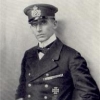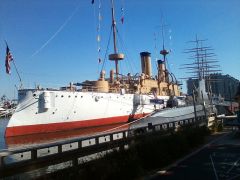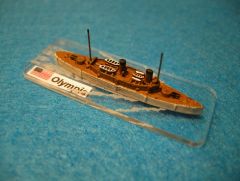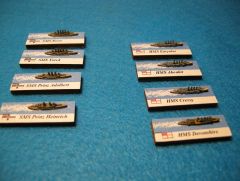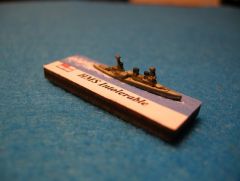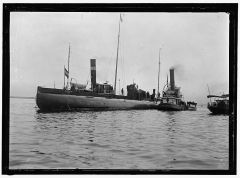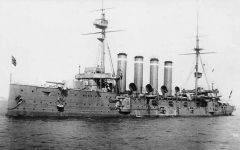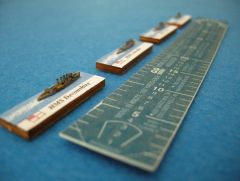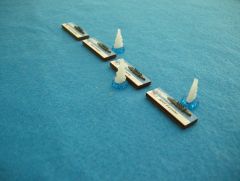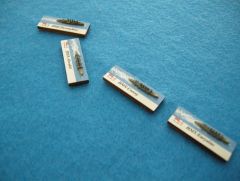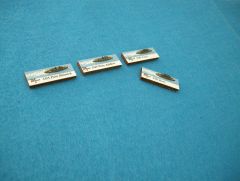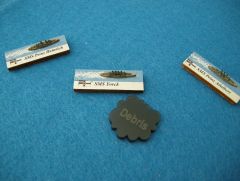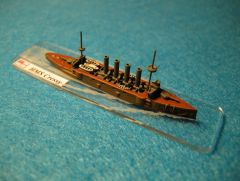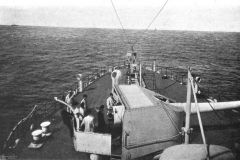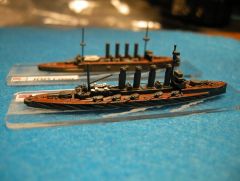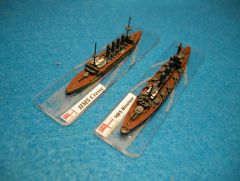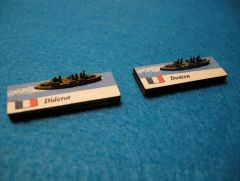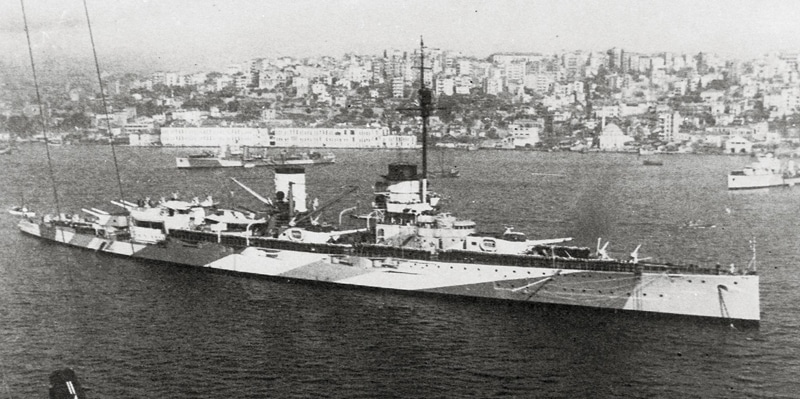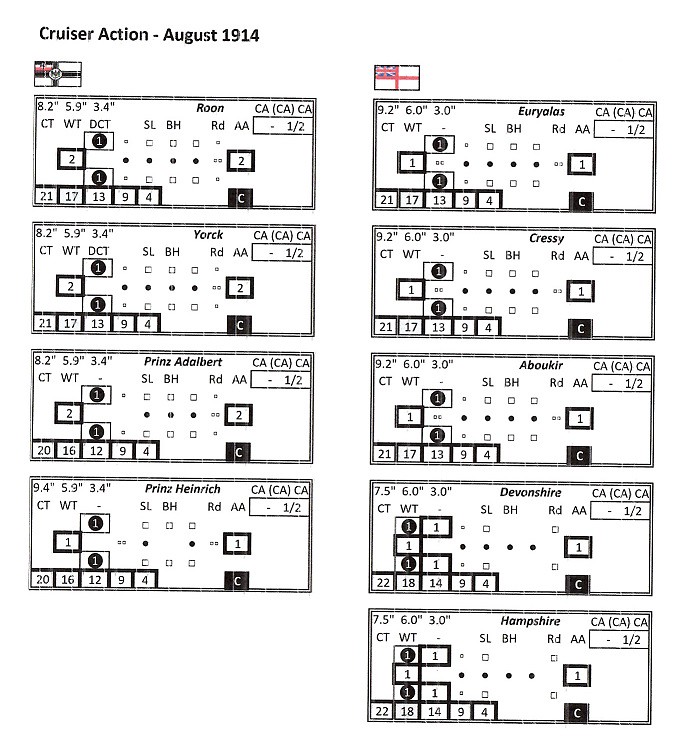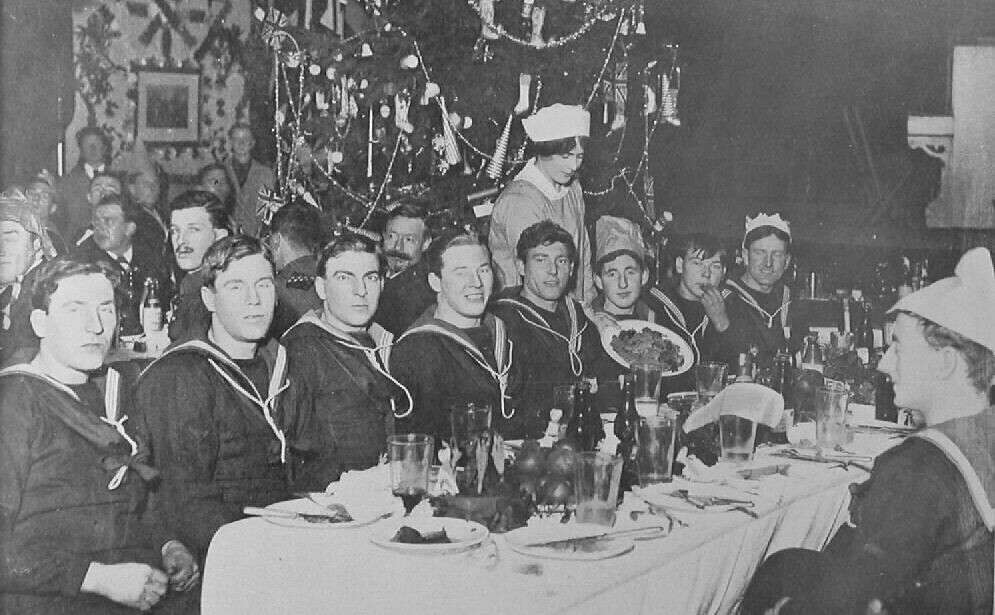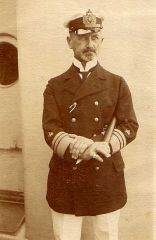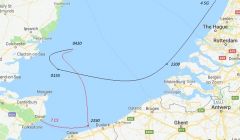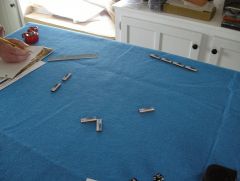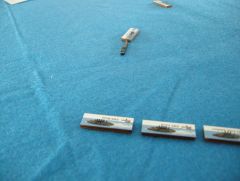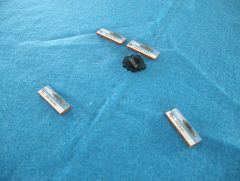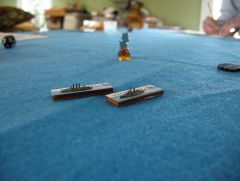Cruiser Action – August 1914 (Hypothetical)
Setting
During the second week of August 1914 High Seas Fleet commander Admiral von Ingenohl dispatched the old cruisers of the 4th Scouting Group on a sweep of the southern end of the North Sea in preparation for a larger action later that month (culminating in the First Battle of Heligoland Bight). It was hoped that this force could disrupt the reported British minelaying and sweeping activities reported since the first days of the war.
The 4th Scouting Group exited the Jade on the evening of August 8 turning west to proceed down the coast. Commanding Rear Admiral von Rebeur-Paschwitz continued to a point twenty miles west of Domburg where, having encountered no enemy activity, he ordered a turn due west. At 0100, having continued sixty-five miles and still having encountered nothing, he ordered a great arcing turn to the northwest before setting course for home.
Unbeknownst to Rebeur-Paschwitz his movement had been observed and reported by a British trawler hours earlier before he’d made his turn west. An ad hoc force of cruisers had been dispatched from Dover intent on intercepting the German force whose intentions were unknown. Henry H. Campbell, commander of the 7th Cruiser Squadron was placed in command of the group.
Campbell, his force comprised of four old armored cruisers of which three were crewed by reservists, initially made the presumption that the German would attempt to run the Strait and break into the Channel. He positioned himself on the eastern edge of the Broads proceeding along the French coast on a course opposite the last reported for the Germans. After two hours with no contact and no further reports he changed course turning due north. He continued for fifty minutes on this course, then turned northwest increasing speed to 18 knots. Simultaneously there were no reports by destroyers patrolling the strait indicating the Germans had slipped west of him and were continuing into the Channel. Somewhere in front of him was the enemy.
Campbell's flagship, HMS Euryalus.
After ninety minutes Rebeur-Paschwitz had completed his wide turn and was continuing on an ENE heading at 15 knots. With sunlight emerging lookouts on SMS Roon reported smoke on the horizon off their starboard quarter. Charts indicated their positon was approximately forty-five miles due east of Clacton-on-Sea, a long way from home. Rebeur-Paschwitz ordered a course change to due east and a slight increase in speed to 16 knots.
Order of Battle
High Seas Fleet
4th Scouting Group – Rear Admiral Hubert Rebeur-Paschwitz
SMS Roon (Flag)
SMS Yorck
SMS Prinz Adalbert
SMS Prinz Heinrich
Grand Fleet
Dover Force – Rear Admiral Henry H. Campbell
HMS Euryalus (Flag)
HMS Cressy
HMS Aboukir
HMS Devonshire
Snapshot of log-sheet:
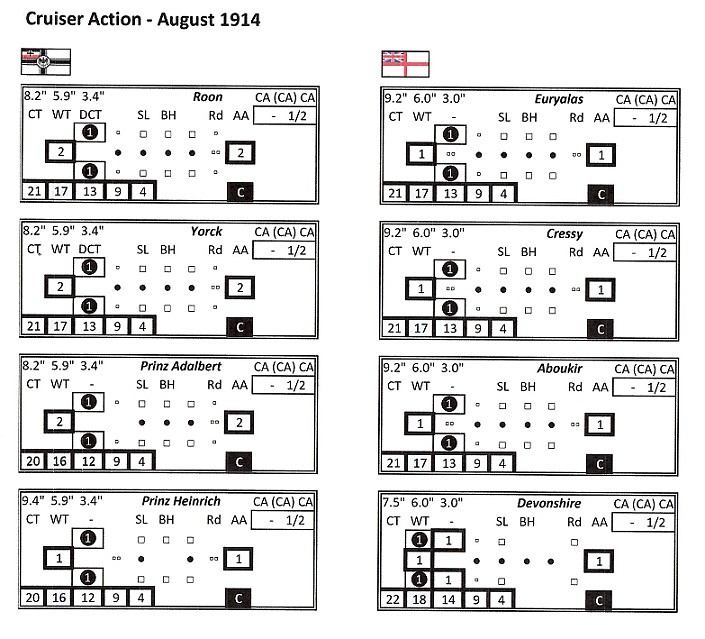
Conditions
Clear skies, calm seas.
After-Action Report
At 0520 spotters on HMS Euryalus reported smoke on the horizon off her starboard beam on an easterly heading. Campbell immediately ordered a hard turn to starboard toward the unidentified ship(s) and a speed increase to 20 knots. Now, with the turn completed and the unidentified target off his port bow, Campbell hoped to run it down.
By 0555 Campbell had gotten a good look at his adversary. Still nearly ten miles off, the enemy force was reported to comprise three cruisers and one light cruiser running at approximately 17 knots on an eastward heading. Simultaneously he received a communication advising him that a second intercepting force had been dispatched, this from the Nore comprised of one light cruiser and ten destroyers. Nearly seventy miles behind him, Campbell considered it unlikely that the Nore force could reach the enemy on his current heading and speed without being baited or damaged.
Campbell's force heads northeast.
Campbell’s three largely-obsolete Cressy-class cruisers were manned by RN reservists. While these men had been vigorously trained and drilled on the run-up to war there was still considerable doubt regarding their capabilities in action. Devonshire, crewed by RN regulars, had primaries of just 7.5-inch. This together with the old cruisers’ fewer main armament tubes put him at a considerable disadvantage. Undaunted, Campbell pressed on.
By 0618 the range had closed to just over 15,000 yards. Spotters on Euryalus had revised their force composition report to four cruisers, noting the fourth ship in the enemy’s column to be SMS Prinz Heinrich, the old 1902 armored cruiser. Campbell maintained his course but increased speed to 21 knots, continuing to close on the German column.
By 0630 Rebeur-Paschwitz had been observing the closing enemy force for nearly an hour. Now he ordered a ten degree turn to the southeast hoping to cross the Brit’s column at a favorable opening range. With a nearly two-to-one gunnery advantage he looked to quickly reduce the enemy force. However, he had an issue with his third cruiser, Prinz Adalbert, which was reporting a minor boiler problem. Now disinterested in a full-on fight, he hoped to give these old British cruisers a bloody nose while maintaining his current course for home.
At 0636 Roon and Yorck opened on the British column at 13,900 yards without effect. Adjusting for the closing range Yorck managed to hit Aboukir on her next salvo, striking her below the waterline flooding a number of compartments. Aboukir’s speed immediately dropped to 17 knots (for which Campbell adjusted his column speed so that she can maintain position). Twelve minutes later Roon scored a hit on Cressy, taking out her aft main gun. The range has now closed to 10,800 yards. Campbell orders return fire and misses everything.
The British column comes under fire.
The range closes rapidly and by 0700 it is just 9,800 yards. Roon and Prinz Heinrich both fire and miss, but Yorck hits Aboukir again, destroying her aft turret, penetrating to the magazine below. Captain Drummond orders the magazine flooded successfully averting disaster. The British, their force rapidly degrading, again returns fire without effect.
Campbell elects to continue on his present course. His next salvo at 0706 again fails to find the target. Roon and Yorck miss on their next round, but Prinz Adalbert takes up fire on Aboukir holing her below the waterline again, dropping her speed to 13 knots. Prinz Heinrich finds Devonshire, similarly blowing a six-foot hole in her hull beneath the bridge causing minor flooding but dropping her speed to an 18 knot maximum.
From the bridge of Euryalus Campbell now contemplated his next move. Eddie Underhill, captain of Devonshire, lobbied for a torpedo attack but Campbell declined, knowing that it would take nearly a quarter-hour to turn, position and launch such an attack with highly doubtful odds of success. With speeds falling and more than twenty percent of his main armament gone, Campbell orders one final salvo at ever-shortening range, then a turn south to retire.
At 0712 Euryalus again takes up fire on Roon, this time delivering a 9.2-inch round which penetrates her armor-belt below the waterline. Rear Admiral Rebeur-Paschwitz is knocked to the deck by the impact as Roon heaves sharply to port before righting herself. Damage-control reports a bulkhead hit amidships with uncontrolled flooding. Despite rising water in her forward boiler-room the ship is able to maintain her speed of 16 knots temporarily as damage parties desperately try to contain the inrush.
Meanwhile Devonshire puts a 7.5-inch on Prinz Heinrich’s bow, destroying her starboard torpedo tube and causing minor flooding (1/2 hull-box). Cressy and Aboukir’s fire all miss.
The Germans are not silent. Roon’s simultaneous fire on Euryalus passes safely overhead, but Yorck hits Cressy again, smashing one of her 3-inch mounts, downing her foremast and carrying away her searchlights. Aboukir suffers yet another hull hit from Prinz Adalbert, her speed now falling to just nine knots. Down by the bow, her rear deck wrecked and littered with dead, Aboukir fails her morale check and turns out of the line.
Campbell orders an 18-degree turn to the east, executed by Euryalus and Cressy. Aboukir turns even sharper, slipping out of the column. Devonshire swings wide to port to avoid colliding with slowing Aboukir, carrying her ever closer to the German column.
Campbell orders his line to retire.
Rebeur-Paschwitz has issues of his own. Roon, still unable to contain her flooding, loses another hull-box with her speed falling to 13 knots. She has simultaneously developed a six-degree list to port rendering her main armament ineffective to starboard. Yorck and the rest of the column heel sharply to port to avoid the slowing Roon, temporarily taking them off their firing line while passing beyond the stricken ship.
The German column pushes past the stricken Roon.
Even as Devonshire turns out of the line she exchanges another broadside with Prinz Heinrich, scoring a pair of 7.5-inch hits which fail to penetrate. Prinz Heinrich's fire misses.
By 0724 Roon has nearly stopped and is settling by the bow. Her forward engine room is flooded, fires out. The crew is still unable to staunch the flooding. Yorck is ordered alongside to take Rebeur-Paschwitz and his staff off while Prinz Adalbert and Prinz Heinrich stand off guarding the operation. At 0736 the captain ordered Roon abandoned, with the ship capsizing to sink six minutes later.
SMS Yorck picks up survivors as Prinz Heinrich and Prinz Adalbert stand off.
Campbell seized the moment and turned south, similarly guarding the limping Aboukir in his withdrawal. Given the composition of his force, he had snatched victory from the jaws of defeat (almost entirely due to extraordinarily bad damage-control die rolling by the Germans). With the Nore force approaching from the west he leaves the Germans to their fate.
In the coming months Cressy and Aboukir would be sunk by U-9. Devonshire would be redeployed north to patrol the North Sea and Euryalus was soon sent to the Med. Yorck would stumble into a friendly minefield and be lost before the end of the year. Rear Admiral Rebeur-Paschwitz together with Prinz Adalbert and Prinz Heinrich would be sent to the Baltic to fight the Russians. Prinz Adalbert would be torpedoed and sunk by E8 in October 1915, destroyed by a massive explosion of her magazines. In early 1916 Prinz Heinrich was retired.
Observations
The scenario offers a striking comparison of British and German cruiser capabilities at the turn of the century. Roon and Yorck proved the class of the table with their twin 8.2-inch turrets and fire-control. The British, to have any chance in this running battle, needed to rapidly close the range in the face of such effective fire by the Germans and proved unable. Secondary fire had no penetration at the ranges seen here. A turn north by Campbell to cross behind the German column might have shortened the odds (as well as the length of the game) considerably, presuming more effective fire by the old cruisers and Rebeur-Paschwitz's relentless run to the east-southeast.
Campbell's flag Euryalus dealt the decisive blow of the day, only made possible by the German's ineffective damage-control efforts (read die-rolling). Despite this being a 1-6 roll (50-50 shot) over five consecutive turns, I've seen this happen a number of times during sessions. Nothing more frustrating than watching an otherwise undamaged ship sink beneath your feet due to a string of crummy DC die-rolls, but then that's one of the things that makes playing at this so great.
The result this day was seemingly a British victory, one that looked to be heading toward disaster just a few turns earlier. Presumably Rebeur-Paschwitz got his surviving ships back underway and headed home before the Nore force arrived. Perhaps a rematch is warranted after a revisit of the OB, and maybe the weather won't be so cooperative next time. Best thing was we played the whole thing in a bit less than ninety minutes...almost scale time!
Tried to provide everything here for a replay...give it a shot and post the results.
Healey



